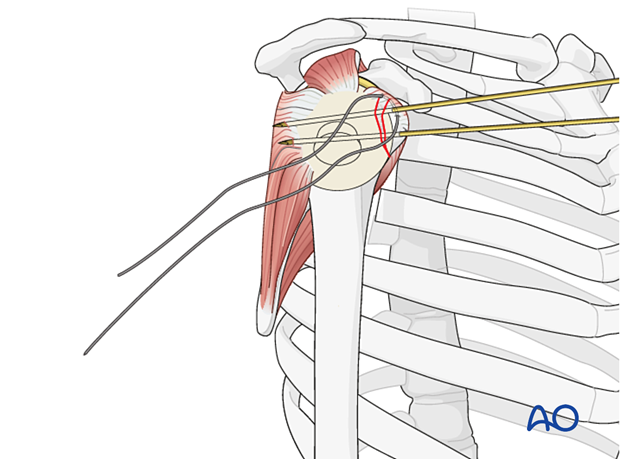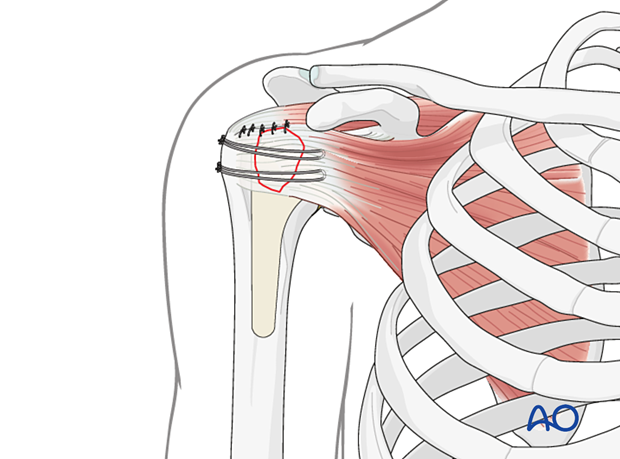ORIF - Suture or screw fixation
1. Principles
The presence of a stemmed humeral component means that there is inadequate bone stock to perform a screw osteosynthesis. For this reason, suture fixation is the preferred treatment option. An example of a completed construct is shown in this illustration.

In the case of a reversed shoulder prosthesis, the need for continuity of the subscapularis to the humerus is debated.

2. Patient preparation and approaches
Patient preparation
It is recommended that this procedure is performed with the patient in a beach chair position.
Patient positioning should be discussed with the anesthetist.

Approaches
The deltopectoral approach is used:

3. Reduction and preliminary fixation of the lesser tuberosity
Traction suture insertion
Insert traction sutures through the subscapularis tendon.

Fracture bed preparation
Irrigate the fracture bed and remove any hematoma. Prepare the margin of the fracture by removing or reflecting the periosteum, 2–3 mm back from the fracture line.

Reduction
Reduce the lesser tuberosity by traction on the traction suture(s).
- Be careful not to fix the fragment too far laterally, to avoid loss of external rotation
- Be careful not to fragment the tuberosity with bone-holding clamps

Preliminary fixation
An attempt can be made to temporarily secure the reduction with one or two K-wires. However, the presence of the humeral component may make this problematic. In such cases, manually holding the fragment in place may be necessary.

4. Fixation
General considerations
There are several techniques for fixing the lesser tuberosity. The choice depends on the following:
- Presence of humeral stem
- Size of the fragment
- Bone quality (osteoporosis)
- Degree of fragmentation
- Available bone stock

5. Suture fixation
The sutures can be placed in patterns that are optimal for stabilizing comminuted fractures.
A detailed description of suture fixation technique is given in the AO Surgery Reference Proximal humerus module.

6. Screw fixation
Achieve preliminary fixation as shown above. Then insert at least two appropriately-sized screws to ensure rotational stability. Screws should engage the posterolateral cortex, distal to the articular surface. Cannulated or standard screws may be used.

Combination of screw fixation and suture fixation
Screw osteosynthesis can be augmented using the beneficial effect of suture neutralization or cerclage suture techniques.

Repair of the rotator cuff interval
Place several additional sutures or a running suture to close the lateral portion of the rotator cuff interval between the supraspinatus and subscapularis tendons. Any rotator cuff tear identified should also be repaired.

7. Final check of osteosynthesis
The C-arm must be directed to allow orthogonal views. Position the arm as necessary to confirm that reduction is satisfactory, fixation is stable, and the screws are of appropriate length.

8. Aftercare
Postoperative phases
The aftercare can be divided into four phases of healing:
- Inflammatory phase (week 1–3)
- Early repair phase (week 4–6)
- Late repair and early tissue remodeling phase (week 7–12)
- Remodeling and reintegration phase (week 13 onwards)
Full details on each phase can be found here.













